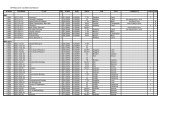Kenwood TH-D7A
Kenwood TH-D7A
Kenwood TH-D7A
Create successful ePaper yourself
Turn your PDF publications into a flip-book with our unique Google optimized e-Paper software.
1<br />
2<br />
3<br />
4<br />
5<br />
6<br />
7<br />
8<br />
9<br />
10<br />
11<br />
12<br />
13<br />
14<br />
15<br />
16<br />
17<br />
18<br />
19<br />
20<br />
21<br />
22<br />
23<br />
PREPARATION FLOW<br />
The following steps should guide you to a good start of<br />
packet operation. The shaded steps indicate operations<br />
on your personal computer. First connect the<br />
transceiver to the personal computer {page 53}.<br />
Note: You may switch Battery Saver OFF {page 49} to prevent the initial<br />
portion of a received packet from being missed.<br />
54<br />
q Install an appropriate communications program on<br />
the personal computer.<br />
• A variety of freeware or shareware programs can be<br />
obtained in various ways. Consult your reference<br />
material or other “packeteers”.<br />
w Initiate the communications program and set the<br />
following parameters on the personal computer:<br />
• Transfer rate (TNC Computer): 9600 bps<br />
• Data length: 8 bit<br />
• Stop bit: 1 bit<br />
• Parity: Non<br />
• Flow control: Xon/Xoff<br />
e Access Menu 1–4–1 to select band A or B as the<br />
data band {page 55}.<br />
r Press [TNC] to switch ON the TNC.<br />
• “ ” appears.<br />
t Press [TNC] again to enter Packet mode.<br />
• “PACKET” also appears.<br />
y To select 9600 bps as the transfer rate from/to the<br />
target station, type HBAUD (or HB) 9600 and<br />
press [Enter] or [Return]. The default is<br />
1200 bps.<br />
• You must select the same transfer rate as the target<br />
station.<br />
u Type MYCALL (or MY) then your call sign (9 digits<br />
max.) and press [Enter] or [Return] to set your<br />
call sign on the TNC.<br />
• You cannot use the default setting (NOCALL).<br />
i Tune to an appropriate frequency.<br />
• First you may want to monitor packets which are<br />
transmitted among other stations. When packets<br />
are received, text appears and the computer screen<br />
scrolls.<br />
o To connect with the target station, type<br />
CONNECT (or C) then its call sign and press<br />
[Enter] or [Return].<br />
• When a linkage is established, a message which<br />
informs you of it appears on the computer screen;<br />
on the transceiver display, “ ” appears.<br />
• If packets from other stations keep your squelch<br />
open, adjust the squelch level in advance. The TNC<br />
cannot transmit in such a situation.<br />
!0 Send appropriate commands and, if necessary,<br />
messages to the target station via the TNC.

















